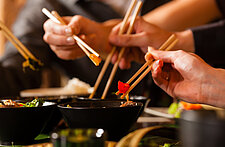Hispanics are the single fastest growing group of minority consumers in the U.S. today, making them an increasingly important focus for food and beverage producers and retailers who are looking for an edge in a hyper-competitive market. In this article, we’ll take a look at the factors behind the growth of the U.S. Hispanic market, as well as its current and anticipated geographic distribution. We’ll also spend some time discussing the effects of age, acculturation, and other factors that lend variety to a group that can sometimes seem monolithic to those acquainted with it only at a basic level. With those factors in mind, plus some cultural influences common to most Hispanics, we’ll then examine the effects of recent economic events on this burgeoning food and beverage consumer market.
Hispanic Population Growth Rates by Region
Perhaps because of its proximity to the nations mentioned above, the South boasts the fastest growing Hispanic population in the U.S. The Midwest, however, comes in a close second. The West, on the other hand, is slowing when it comes to Hispanic population growth, although it still leads in overall numbers of Hispanics in the country at large, where every region has experienced more than 30% growth in Hispanic populations from 2000 to 2010. This growth has not been uniform. From the groups predominantly represented in U.S. Hispanic populations, those of Mexican, Puerto Rican, Cuban, and Central American origin, Central American Hispanic populations in the U.S. have grown by 137% from 2000-2010, by far comprising the fastest growing group.
INFOGRAPHIC: Key Hispanic Flavors in the U.S.
For food and beverage producers and retailers, there is the need to plan future strategies that not only account for nationwide demographic changes and regional demographic shifts, but also consider the changing balance of subgroups within the Hispanic population. In developing strategies, it’s wise to understand the ramifications of Hispanic culture, which, like most cultures, is a patchwork of many cultural traditions and preferences at a variety of levels of acculturation, age, income, and other factors.
Cultural and Environmental Effects on Hispanic Food and Beverage Consumption
As stated, Hispanic culture is diverse. But despite regional variations, there are common threads. The following cites a few of those commonalities, as well as the differences created by varying traditions in the country of origin – age, income, environment and other factors. Family, defined broadly to include extended relatives, is of prime importance in Hispanic culture. When one member of the family suffers, all feel the pain. When one triumphs, everyone smiles. Because family is central to Hispanic culture, get togethers at holidays, family events and religious observances are frequent, with foods and beverages often taking center stage.
WHITE PAPER: Hispanic Snacking Trends & Drivers
Traditionally, Hispanics tend to make lunch (el almuerzo) the main meal of the day, eating small amounts at breakfast and dinner, which can be served as late as 8:00 pm or 9:00 pm. Hispanics who adhere to this schedule, typically those who are less acculturated, older, or who simply wish to honor and preserve their heritage, may also take time out for la merienda, a light snack in the early evening. However, these individuals tend to be in the minority, thanks to the effects of American work and school schedules and other factors that encourage a less traditionally Hispanic approach to meal size and timing. The composition of meals can vary widely depending on the country of origin. Hispanics of Mexican origin, particularly those most likely to maintain a traditional meal schedule, often lean toward meals centered on tortillas, beans, and chili peppers, plus meats that include pork, beef, and chicken as well as goat and lamb. Cuban cuisine makes heavy use of rice and beans and pork or beef, while Central American ingredients range from stuffed yucca to seaweed, in addition to staples found throughout Hispanic cuisine.
INFOGRAPHIC: Hispanic Beverages
No matter what their preferences in food, Hispanics, like other groups, are still reeling from the effects of the recent recession, and this can play a part in what they choose to eat and drink, as well as how often. Because the Hispanic population is growing rapidly, family sizes tend to be larger and consist of more children, increasing the impact of economic instability. Combined with a growing number of U.S. born Hispanics, who more frequently tend to readily embrace American culture and foods, the trend toward larger family sizes and correspondingly reduced food and beverage purchasing power are changing the way some Hispanics shop, particularly when it comes to buying premium/lifestyle brands.
Today’s food and beverage producers and retailers are facing change at an unprecedented scale, particularly when it comes to market demographics and buying patterns. Hispanics, as the fastest growing ethnic group in America, are quickly becoming a dominant factor in determining product mix, pricing, positioning, and other strategic moves. Food and beverage producers and retailers will survive this market shift, increase market share and position their brands for long term success only when they fully understand this vibrant, living culture and the subgroups within it.
Check out PART 1 of Understanding the Rise of Hispanic Consumers in the U.S. HERE




